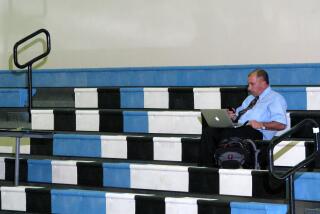Send In the Clowns : Some local sportscasters try almost anything for popularity . . . and frequently they outshine the news anchors
During a TV interview, Keith Jackson, the leviathan tight end of the Philadelphia Eagles, elected to hold the earpiece used to hear his questioner by pressing his enormous fingers against his ear. After airing the interview on KCBS-TV Channel 2, wisecracking sportscaster Keith Olbermann summed up Jacksonâs provocative comments about illegal payments to college athletes, quipping: âJackson said he would wait until the Eagles playoff games were over before having surgery to remove his hand from his ear.â Channel 2âs entire news team then signed off the show . . . with their own fingers stuck in their ears.
At KCOP-TV Channel 13, lunatic sportscaster Vic (the Brick) Jacobs, decked out in spiked hair and bolo tie, punctuates his denunciation of some sports superstar for stupidity beyond the norm by hurling a plastic-foam brick at the camera.
KNBC-TV Channel 4âs coverage of Kareem Abdul-Jabbarâs interminable farewell trek through the cities of the NBA makes use of a cardboard map of the United States, upon which mischievous sportscaster Fred Roggin glues a miniature of the gift each team has presented to the great center. Rogginâs biggest worry is whether heâll be able to fit all of Kareemâs paste-up presents on his poster-sized map.
Maps, bricks, bloopers, puns, camel races, obscure references to French literature or country and Western tunes and Robin Givens slurs interwoven with the scores of the day: Such is the stuff of sportscasting on the local news--a high-stakes sport in itself these days where lunacy and outrageousness are translated into big bucks and big ratings.
Sports personalities such as Roggin, Olbermann and Jacobs, through their very outrageousness and high visibility, have become as well known if not more popular than many of the news anchors they work with. Like the clowns in the circus, they have begun to outshine their more serious colleagues, and theyâve driven their more straightforward counterparts, including KABCâs Jim Hill, the dean of local sports anchors, into relative obscurity.
Last year, with Olbermann jumping from independent KTLA to CBS-owned Channel 2, Channel 13âs replacing the straightforward Mike Chamberlain with the crazy âVic the Brick,â and Rogginâs continuing reign as the most popular sportscaster in town, the importance of the sports personality to a local newscast loomed larger and larger.
Management at several stations concluded that sports shenanigans for four or five minutes a newscast and the opportunity to promote a charismatic, even wacky, sports personality is what it takes to compete in the cutthroat world of local news.
But at what cost?
Thereâs no denying that the antics of Roggin and his comrade in comedy, weatherman Fritz Coleman, and KNBCâs persistent promotion of its goofy, yuppie duo helped catapult the Channel 4 News to the top of the Nielsen ratings for the first time in more than a decade. But there are some who contend that this no-holds-barred reliance on humor and entertainment trivializes the newscast--that by shifting so unself-consciously from the serious news of the day to the bloopers and one-liners of the sportscaster, television stations are in danger of junking the credibility of the entire news operation.
âPeople like Roggin and Olbermann really are performers,â said Dan Gingold, assistant professor of journalism at USC and a former executive producer of news and documentaries at Channel 2. âTheyâre up there on the news doing one-liners and Iâm waiting to hear the rim shots. Itâs what used to be called gonzo journalism. The story centers on the reporter rather than on what he is reporting, and I think that is a line that should not be crossed.
âIn the guise of a legitimate news broadcast, when you step into the role of a performer, it calls into question the whole nature of news and the news service. If you can do it with sports, you can do it with anything. Next, we could see a reel of gaffes and bloopers featuring the presidential candidates.â
But John Rohrbeck, KNBCâs general manager, who promoted Roggin and his tomfoolery ahead of longtime straight-ahead sportscaster Stu Nahan several years ago, believes that the news audience craves something sweet and light to break up the somber tone of the newscast. And sports, he said, is just the place to give viewers what they crave.
âShould you try to make something dull in order to become journalistically responsible?â Rohrbeck said. âI donât think showing an elephant race for 20 seconds at the end of the sportscast trivializes the news portion. There are nights when I want to put my head under the pillow because the news is so dreadful: a plane crash, a murder, another gang shooting. To come in with something that is fun and at least lets you go to sleep with a smile rather than the feeling that it would be better if the world ended tonight, I donât think there is any conflict at all.â
âI did say two years ago that during an earthquake your chances were 1 in 3 of being crushed by a Fred Roggin billboard. That certainly is a danger,â said Keith Olbermann, joking his way into a defense of his rapid-fire, satirical, joke-every-10-seconds broadcast style. âAnd I suppose that if all you did was humor--people falling down, blood-and-guts cartoon video--then the sportscast would be a danger to the newscast. But as long as you cover the industry, report the scores and maintain a context of being journalistically sound, I donât think you have to be a full-time journalist.
âSports is an aspect of life that is sometimes poignant, sometimes sad, sometimes inspiring and sometimes itâs funny. For years growing up watching sportscasters read off the scores, I never saw that. Then I read Jim Boutonâs âBall Fourâ and it was a revelation. These were human beings, they werenât bubble-gum cards. They were people who did stupid things and played pranks and spit on each otherâs birthday cakes.â
If it spits, especially during baseball (a.k.a. tobacco-chewing) season, you can be sure that âFredâll show it to you.â Fred Roggin, 31, came to Channel 4 in 1980 as a 23-year-old weekend sports anchor after a stint as ârock ânâ roll Rogginâ on a radio station in Yuma, Ariz., and a brief apprenticeship as the sportscaster at the NBC affiliate in Phoenix.
When Roggin hit town, sportscasts were a pretty dull lot on all three network-owned stations: a Rams preview featuring an interview with some player about the upcoming game, Dodgers highlights, Angels highlights, âsee you at 11.â KABCâs Ted Dawson yelled a lot, but neither he nor KCBSâ Jim Hill (now sportscaster at Channel 7) nor KNBCâs Stu Nahan (now at Channel 5) ever deviated from the old-time sportscaster script.
Roggin, with his âHall of Shameâ reel of video bloopers, âRogginâs Heroesâ featuring the weekâs best plays and âthe sports soapboxâ on which the average Joe in a shopping mall can stand up and say âanything about sports,â changed that fast.
âFor years, sports in this market was quite staid, quite dead-ahead,â said Erik Sorenson, news director at KCBS. âKNBC and Roggin changed all of that. Fred developed a very good following covering sports but emphasizing the offbeat and a sense of humor, focusing on the lighter side of sports. It has changed the way people do sports and it has changed the way people get sports. It makes sports much more palatable for people who donât like sports, and in terms of television, it certainly has made sports a bigger part of the competitive game.â
Competition--more specifically, cutting into Rogginâs fun-loving sports audience--is the reason Sorenson hired the quick-witted Olbermann away from Channel 5 last September, according to KNBCâs Rohrbeck.
âIt wasnât so neat and orderly as to say âthereâs Roggin, heâs killing us, what can we do to combat him,â â Sorenson said. âKeith was becoming available and we had admired his work for a long time and we wanted him.â
A year earlier, when Jim Hill, longtime, serious-minded KCBS sportscaster and ex-pro footballer, jumped over to Channel 7 for a reported $750,000 a year, Channel 2 tried to counter Rogginâs success by luring ABC Sports alum Jim Lampley, a man with a reputation for covering sports in the same manner that television journalists cover the Pentagon, to local TV in Los Angeles with a combined network-local package that paid him about $1 million annually. (Roggin is about to enter the final year of a four-year contract worth $300,000 annually. He is expected to get a big raise when that contract expires.)
Lampleyâs newsy approach to sports, however, isnât suited to a local sportscaster, Rohrbeck and Roggin said. Realizing that, Channel 2 moved Lampley to news anchor and grabbed Olbermann for a reported $250,000 a year when his contract with Channel 5 expired.
But Sorenson, whose newscasts have been trailing the other two network-owned stations badly in the local news ratings race, denied that the changes in his sports and news staffs were quite so calculated. In his opinion, Olbermann was simply the best local sportscaster in the market.
âKeith does something that sets him apart from Roggin and all the rest. Heâs a crossover. Heâs like a cross between Lampley and Fred Roggin. He can be funny and irreverent and make sports more watchable, but he knows as much about sports as anyone else. He has an encyclopedia for a brain.â
He also has a wicked sense of humor--a mean streak as long as Abdul-Jabbarâs list of NBA records. One local television critic has even called him âthe Dr. Mengeleâ of the sports world. But while Olbermann, who likens his style to âexploding beans,â is caustic, vicious and opinionated, he is also the intellectual of the local sportscasting bunch. His reports are as likely to contain a reference to Marcel Proust as they are to have a bad pun about the rear end of some bent-over pro golfer.
But no matter how weird or wacky they get, both Olbermann and Roggin come across as one of the guys--a sports fanâs best friend.
Channel 13âs Vic Jacobs is another story. Hired by KCOP last August, Jacobs is straight out of the Joe Piscopo school of sportscasting--a guy who gives you the sports scores while ridiculing people like Roggin. With his spiked hair, bolo tie, absurd loud-mouthed delivery and foam brick, Jacobs made fun of everyone by making a semi-idiot of himself.
âWe decided to try something a little crazy,â said Ed Coughlan, KCOPâs news director. âNo one else does this kind of shtick. Itâs a parody of a sportscaster done by a guy who loves sports but not necessarily sportscasters.
âClearly we could only do this kind of thing in sports. Roggin and Olbermann have their tongue firmly planted in their cheeks and theyâve shown that people get off on it. Thatâs what a news director looks for--someone who gets talked about.â
Coughlan insisted that Jacobsâ pushing the boundaries of what weâve come to expect from a sportscaster does not detract from the seriousness and credibility of the rest of the newscast, even though the station did ask Jacobs to ditch the spiked hair and wear a regular suit and tie after several months of negative reviews in the press and some criticism from the viewing public.
âWe decided that the attire was getting in the way of what he was trying to deliver,â Coughlan said. âHeâs easier to understand now because there is less stuff to get through.â
Despite Jacobsâ cleaned-up appearance, Jeff Wald, news director at Channel 5, believes that parody has no place on a local newscast. Wald, who employed Olbermann for three years at KTLA before opting for the gray-haired, well-known Stu Nahan when his funny man moved to KCBS, understands that competitive pressure drives news directors to think that comic personalities make a newscast more watchable.
âBut there are very few Keith Olbermanns and Fred Roggins,â Wald said. âAnd then there are a lot of people who are simply charlatans and imitators.â
But some local news observers donât agree that Olbermann and Roggin, because of their popularity and adequate sports knowledge, are beyond criticism. USCâs Gingold sees two problems with using comedians as part of a newscast. First, stations such as KNBC use Roggin to promote their hard newscast, and in the process, Gingold said, it drags the rest of the news staff down to his level.
In one comic spot featuring Roggin, Fritz Coleman and anchorman Jess Marlow, Roggin and Coleman induced Marlow into an arm wrestling match and then left him holding a fake arm--the butt of a cheap sight gag. Gingold contended that such promotional stunts hurt Marlowâs credibility and blurs the line between the stationâs commitment to news and its commitment to entertaining.
Even more damning than the pranks and promotion, however, is the fact that Gingold believes the tomfoolery of the sportscaster leaks out and infects all of the people on the news set.
âTV news involves everybody,â Gingold said. âEveryone on the set ends up sitting there, snickering and doing one-liners with the sports jock simply because he tosses off the material to the legitimate news people. The anchors are drawn into the game and that tends to trivialize if not the material then the people who are supposed to be trusted purveyors of the news.â
âSports is entertainment, pure and simply, and entertainment doesnât have to be all facts, stats and scores,â argued KNBCâs Rohrbeck. âItâs supposed to be fun. It doesnât hurt our anchors to put a little fun in our newscast. Sports can be a turn off to the non-sports fan, which is 80% of the news audience. If you can show them that they wonât be bored.â
One who disagrees is Irwin Safchik, who throughout the â70s was either news director or executive producer at Channel 4 and who worked there with such sportscasters as Bryant Gumbel, Ross Porter and Stu Nahan. Although he doesnât mind a humorous perspective on sports, he said, he does object to using videotape of non-sports such as belly-flop contests simply for the laugh.
âIt bores me and it offends me,â Safchik said. âOne local sportscaster even seems to think that the funniest thing he can put on the air is a baseball player or umpire being hit in the groin with the ball. That pains me. Theyâre wasting my time as a viewer and also demeaning their news program.â
âI think itâs unfair to criticize us for that unusual piece of video, because we never sacrifice the news of the day to show the funnies,â Roggin argued. âYeah, Iâll show you some Japanese women wrestling because I think thatâs unusual, but youâll still get all the football and baseball highlights, all the major trades. But then if I show you 20 seconds of Japanese women wrestling and the anchors chuckle for a second, I donât think thereâs any harm in that. Itâs offbeat, sure. Itâs a little wild, but we never sacrifice the news to get that in.â
Be it harmless, humorous or heretical, offbeat sportscasting seems to be here to stay. Rogginâs wild and woolly video led his Sunday night sports wrap-up show to victory in the November Nielsen sweeps. Trailing were Channel 7âs Hill, who pioneered the wrap-up genre many years ago with his âSunday Sports Finalâ at Channel 2, and Olbermannâs current version of Sunday night highlights at KCBS.
News purists worry that as Roggin and the others continue to attract more publicity and more viewers than the more traditional sportscasters such as Hill, Nahan and Channel 9âs opinionated but no-nonsense Scott St. James, TV sports personalities will demand more and more time at the expense of other news.
Currently, however, no station is devoting more than five minutes a newscast to sports, and all stations place their sportscast at or near the end of their news shows.
âI donât see any harm in what I do or what Fred or anyone else does,â Olbermann said. âIf it were âAction Sportsâ with Keith Olbermann and now hereâs Jim Lampley with three minutes of news, that would be a perversion of the whole system. People watch the news for the news, and I think they know the difference between the serious stuff that they need to know and the humor I bring from the world of sports. Itâs just one small part of the local news stew, and Iâm confident that the entire history of journalistic integrity at Channel 2 is not going to come crumbling down just because I tell a few bad jokes.â
More to Read
Go beyond the scoreboard
Get the latest on L.A.'s teams in the daily Sports Report newsletter.
You may occasionally receive promotional content from the Los Angeles Times.










